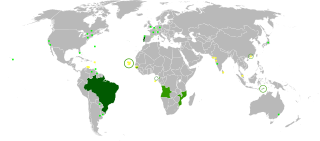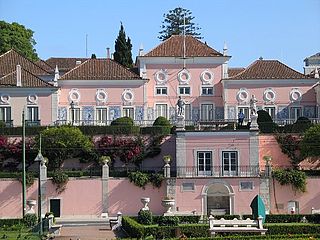
The Belém Palace, or alternately National Palace of Belém, has, over time, been the official residence of Portuguese monarchs and, after the installation of the First Republic, the Presidents of the Portuguese Republic. Located in the civil parish of Santa Maria de Belém, the palace is located on a small hill that fronts the Praça Afonso de Albuquerque, near the historical centre of Belém and the Monastery of the Jerónimos, close to the waterfront of the Tagus River. The five buildings that make up the main façade of the Palace date back to the second half of the 17th century, and were built at a time when the monarchy and nobility increasingly desired to seek respite from the urbanized confines of Lisbon.

The Jerónimos Monastery or Hieronymites Monastery, is a former monastery of the Order of Saint Jerome near the Tagus river in the parish of Belém, in the Lisbon Municipality, Portugal; it was secularised on 28 December 1833 by state decree and its ownership transferred to the charitable institution, Real Casa Pia de Lisboa.

Vila Franca de Xira is a municipality in the Lisbon District in Portugal. The population in 2011 was 136,886, in an area of 318.19 km². Situated on both banks of the Tagus River, 32 km north-east of the Portuguese capital Lisbon, settlement in the area dates back to neolithic times, as evidenced by findings in the Cave of Pedra Furada. Vila Franca de Xira is said to have been founded by French followers of Portugal's first king, Afonso Henriques, around 1200.

Azulejo is a form of Portuguese and Spanish painted tin-glazed ceramic tilework. Azulejos are found on the interior and exterior of churches, palaces, ordinary houses, schools, and nowadays, restaurants, bars and even railways or subway stations. They were not only used as an ornamental art form, but also had a specific functional capacity like temperature control in homes.
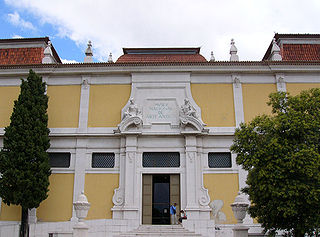
The Museu Nacional de Arte Antiga is an art museum in Lisbon, Portugal.

Cristóvão Lopes (c.1516–1594) was a Portuguese painter.

The National Coach Museum is located on the Afonso de Albuquerque Square in the Belém district of Lisbon in Portugal. The museum has one of the finest collections of historical carriages in the world and is one of the most visited museums of the city.
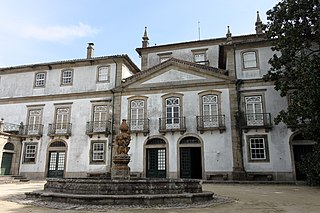
The Residence of Biscainhos, is a former-signeurial residence located in civil parish of Braga, in the municipality of Braga, in northern Portuguese district of Braga.
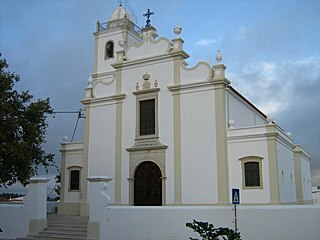
The Church of Our Lady of the Incarnation is a church situated in the civil parish of Porches, in the municipality of Lagoa in the Portuguese region of Algarve.

Gilded woodcarving in Portugal is, along with tile, one of the country's most original and rich artistic expressions. It is usually used in the interior decoration of churches and cathedrals and of noble halls in palaces and large public buildings. An impressive collection of altarpieces are found in Portuguese churches. Originating in the Gothic era, Portuguese gilded woodcarving assumed a nationalist character during the 17th century and reached its height in the reign of King D. João V. In the 19th century it lost its originality and began to disappear with the end of the revival era.
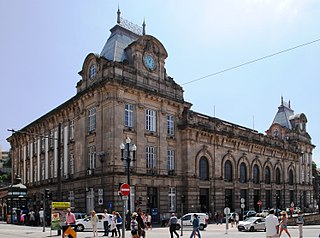
The São Bento Railway Station is a 20th-century railway station in the civil parish of Cedofeita, Santo Ildefonso, Sé, Miragaia, São Nicolau e Vitória, in the municipality of Porto, district of Porto.

Manor of Madre de Deus is a historic former residence of the Bettencourt family in the civil parish of Sé, in the municipality of Angra do Heroísmo, in the Portuguese archipelago of the Azores.
The Sintra Natural History Museum is a museum of natural history located in the historic center of the village of Sintra. The museum has both at national and international level due to the quality and rarity of many of its exhibits.
The Ducal Palace of Vila Viçosa is a royal palace in Portugal, located in the civil parish of Nossa Senhora da Conceição, in the municipality of Vila Viçosa, in the Alentejo, situated about 150 km east of the capital Lisbon. It was for many centuries the seat of House of Braganza, one of the most important noble houses in Portugal which was the ruling house of the Kingdom of Portugal from 1640 until 1910 when King Manuel II, titular head of the family, was deposed in the 5 October 1910 Revolution which brought in a Republican government.

The Museum-Residence Dr. Anastácio Gonçalves is a residence converted to museum theatre, located in the civil parish of Avenidas Novas, in the municipality and Portuguese capital of Lisbon.
Madre de Deus is Portuguese for Mother of God, a Christian title for Mary, mother of Jesus. In English it may refer to:
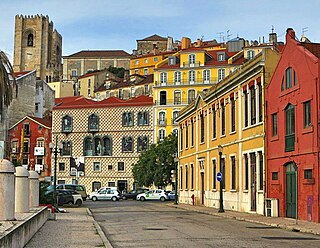
Tourism in Lisbon is popular. The city of Lisbon and the Lisbon metropolitan area attracts a significant number of tourists each year, drawn to its historical and cultural offerings.
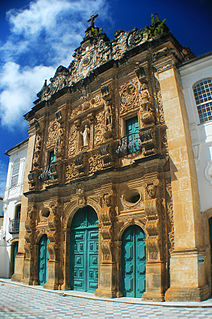
The Church of the Third Order of Saint Francis is an 18th-century Roman Catholic church in Salvador, Bahia, Brazil and seat of the Third Order of Saint Francis in Brazil. The church is one of the main elements of the Historic Center of Salvador and lies within the UNESCO World Heritage Site of the city. It was listed as a historic structure by National Institute of Historic and Artistic Heritage (IPHAN) in 1941. The church was constructed as an annex to the São Francisco Church and Convent. It is noted for its distinctive Plateresque-style façade, an example unique in Brazil.

The Ceramics Museum of Sacavém is situated in the town of Sacavém in the municipality of Loures, just northeast of Lisbon in Portugal. The museum was opened in July 2000 and was constructed on the grounds of a former ceramics factory. Most of the exhibits reflect the output of that factory and its documentation centre is devoted to the study of the history and production of the factory and the industrial heritage of the municipality. In 2002 the museum was awarded the Luigi Micheletti Prize in the Industrial Heritage category.

